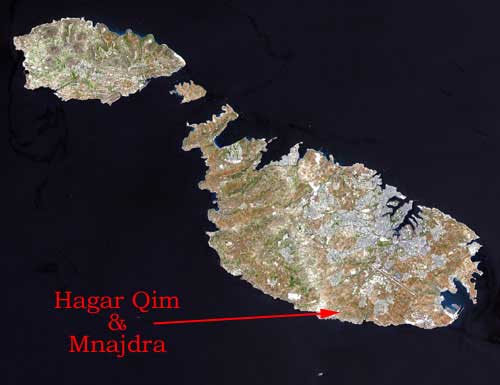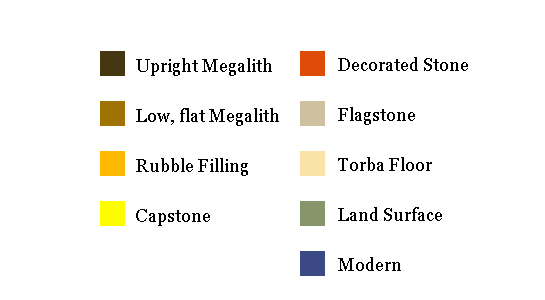

The site lies about half a kilometre down the slope from Hagar Qim on the south coast of Malta. It was first excavated in 1840 but it was not until 1913 that a more rigorous investigation was undertaken by Thomas Ashby of the British School at Rome. The site was a bit of a jumble when Ashby arrived and a good deal of restoration took place as part of the project and during the years since. Most recently this has been in response to a couple of episodes of vandalism. The stones were spray painted in 1996 and a large number of them were toppled over in 2001. The damage has since been put right and security has been increased.
There are three major buildings at Mnajdra, built during the Ggantija and Tarxien Phases (from the middle of the Fourth to the middle of the Third Millennium BC). The two larger buildings, the North and South Temples, are conjoined and form one architectural unit. They were built separately, however, because the terrace on which the southern temple sits is partially supported by its northern neighbour. Excavations in the latter have  produced a mixture of Ggantija and Tarxien pottery, so there is a good possibility that the building was standing in the earlier period and later remodelled. In fact, according to the ceramic evidence, occupation on the site goes back at least as far the Zebbug and Mgarr Periods in the (4100-3600 BC). Because of its simple trefoil plan, the Small Temple is believed to have been the earliest of the three—also dating to the Ggantija Period.
produced a mixture of Ggantija and Tarxien pottery, so there is a good possibility that the building was standing in the earlier period and later remodelled. In fact, according to the ceramic evidence, occupation on the site goes back at least as far the Zebbug and Mgarr Periods in the (4100-3600 BC). Because of its simple trefoil plan, the Small Temple is believed to have been the earliest of the three—also dating to the Ggantija Period.
The three buildings are arranged in a semi-circle and share a common forecourt area formed by the natural rock surface. Hard, durable Coralline limestone blocks were used for the external walls of the temples with the interiors of Globigerinas, which are much easier to carve. It is interesting that at Hagar Qim, which was built at about the same time, the builders apparently could not be bothered going the extra distance to get the more durable material. The buildings themselves are probably the most impressive as far as design, engineering and execution of plan are concerned.


The Small Temple
The Small Temple (left) did not survive particularly well and the rubble walls had totally collapsed leaving only the outline of the floor. What is visible on the site today has been heavily restored. The plan is rather typical, with two outer apses (9) and an elaborate entrance consisting of upright slabs (which did survive) with niches on either side. The innermost space, Apse 10 , is separated from the rest of the building by a screen formed by two taller uprights flanking a line of three slabs. The middle of the three has pitted decoration and there are traces of similar holes on the frontal edge of the flankers.
The South Temple
The Façade of the South Temple
The South Temple, the next to be built, had a concave façade made out of large blocks of Coralline. There were stone benches on either side of the trilithon entrance (now partially restored). When  the North Temple was built, this building underwent substantial renovations.
the North Temple was built, this building underwent substantial renovations.
Room 1 is a large oval space, which includes the two outer apses. The southern apse contains a simple trilithon niche with flanking uprights, built into the interior face of the temple façade. Opposite it was a very elaborate porthole setting (left), which leads to a small room (3) at the rear of the building. The porthole is framed by a trilithon arrangement, which is itself flanked by a pair of upright slabs. All of this stone-work is decorated with pitted dots.
The northern apse connects to an L-shaped room (5) that had evidently been hollowed out of the wall of the temple façade when the North Temple was built. Entry is through a porthole framed within a trilithon. There is a small shrine immediately on the right as you enter the room. A  porthole framed by a trilithon leads to a very cramped space containing a pillar niche. At the other end of the room is a two-storeyed altar made up of two horizontal slabs supported by pillars. Another important feature is a small rectangular ‘oracle hole’ cut through one of the blocks separating this space from Room 1 (right).
porthole framed by a trilithon leads to a very cramped space containing a pillar niche. At the other end of the room is a two-storeyed altar made up of two horizontal slabs supported by pillars. Another important feature is a small rectangular ‘oracle hole’ cut through one of the blocks separating this space from Room 1 (right).
A trilithon doorway, flanked by low stone blocks and a pair of uprights, leads through to the rear part of the building. A small lobby (2) with a small shrine (3) to the left and an apse (4) to the right. There is a trilithon niche at the rear of the temple that is similar to the one found in the  southern apse of Room 1. Room 3 (left) was most likely designed as an apse when the temple was built but was later converted into a small rectangular room. Inside there are two niches—a two-storeyed pedestalled version opposite the porthole from Room 1 and another at the south end of the room, supported by three pillars. The space between Rooms 2 and 3 is taken up by yet another pedestalled altar—so some fairly serious cult activity must have taken place. Room 4 appears to have been a rather typical apse and had no distinguishing features. Room 6 is another oddity because it is only accessible from outside the building and has a rather nicely carved ‘oracle hole’ connecting it with the northern apse of Room 1.
southern apse of Room 1. Room 3 (left) was most likely designed as an apse when the temple was built but was later converted into a small rectangular room. Inside there are two niches—a two-storeyed pedestalled version opposite the porthole from Room 1 and another at the south end of the room, supported by three pillars. The space between Rooms 2 and 3 is taken up by yet another pedestalled altar—so some fairly serious cult activity must have taken place. Room 4 appears to have been a rather typical apse and had no distinguishing features. Room 6 is another oddity because it is only accessible from outside the building and has a rather nicely carved ‘oracle hole’ connecting it with the northern apse of Room 1.
Astronomy
Mnajdra, especially the South Temple, has been the focus of astronomical speculation and it is believed that it was designed to mark certain important celestial events. It has been noted that the main axis of the temple (shown here) faces almost due east, towards the sunrise on the mornings of the spring and autumn equinoxes. On those  particular occasions, the sun’s rays shine the length of the passage. The sun also penetrates the temple at the solstices. At midsummer, a ray of light shines on the upright flanking the decorated porthole leading to Room 3 while at midwinter, it strikes the upright that forms the doorway to Room 2. While these alignments are a little vague and may be entirely due to coincidence, such precision engineering is quite possible in a Neolithic context as the stone circles and tombs of Atlantic Europe attest. In those cases, the builders appear to have used settings of posts to lay out the various lines of sight. A number of post holes have been discovered within sight of Mnajdra and may well have served the same purpose.
particular occasions, the sun’s rays shine the length of the passage. The sun also penetrates the temple at the solstices. At midsummer, a ray of light shines on the upright flanking the decorated porthole leading to Room 3 while at midwinter, it strikes the upright that forms the doorway to Room 2. While these alignments are a little vague and may be entirely due to coincidence, such precision engineering is quite possible in a Neolithic context as the stone circles and tombs of Atlantic Europe attest. In those cases, the builders appear to have used settings of posts to lay out the various lines of sight. A number of post holes have been discovered within sight of Mnajdra and may well have served the same purpose.
The North Temple

North Temple. View of the Terrace, much of it restored
In order to fit the North Temple between its two predecessors, the slope of the hill was terraced to accommodate the southern part of it. The result is that the North Temple is some 3 metres higher than its southern neighbour. It consists of a fairly typical four-apse temple. However, one decidedly unusual feature is the entrance.

The main entrance, the one that is on the main axis of the building, was a porthole, now partly broken but originally nearly two metres high. This was apparently superseded by a more conventional doorway located immediately to its left. This particular configuration is unique to the site and (so far) defies explanation.

North Temple. Masonry in Apse 7
 The outer room (7) is a fairly simple two-apse space with no features of particular importance apart from the exceptionally high quality of the masonry. It was these blocks that were thrown over when the site was vandalized in 2001. At the rear of the room is a trilithon doorway very similar to that which separates Rooms 1 & 2 in the South Temple—an L-shaped arrangement of upright slabs on either side of the door set around a low stone block. The most notable feature is a graffito depicting a temple façade, carved on the south upright of the internal doorway leading to the rear of the building. Room 8 has a rather conventional layout—a pair of apses with a large niche with an altar built into the rear wall on the main axis of the building. On the south side of the room is a porthole (left) leading to a small annex with a pillar altar.
The outer room (7) is a fairly simple two-apse space with no features of particular importance apart from the exceptionally high quality of the masonry. It was these blocks that were thrown over when the site was vandalized in 2001. At the rear of the room is a trilithon doorway very similar to that which separates Rooms 1 & 2 in the South Temple—an L-shaped arrangement of upright slabs on either side of the door set around a low stone block. The most notable feature is a graffito depicting a temple façade, carved on the south upright of the internal doorway leading to the rear of the building. Room 8 has a rather conventional layout—a pair of apses with a large niche with an altar built into the rear wall on the main axis of the building. On the south side of the room is a porthole (left) leading to a small annex with a pillar altar.








